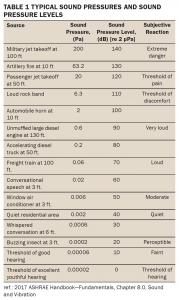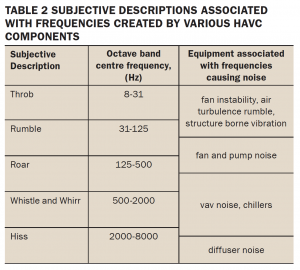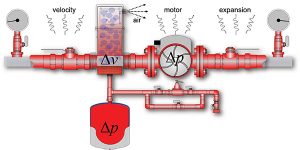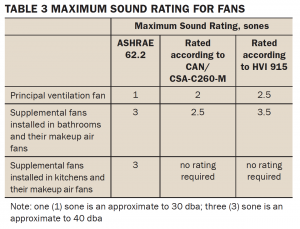
An abridged review of noise sources and methods to control sound transmission
August 24, 2018 | By Robert Bean
Sound complaints are the number one indoor environmental quality problem in buildings today, surpassing thermal comfort, indoor air quality (IAQ) and lighting quality in the hierarchy of occupant discomfort. Objections can be anything from chatter in offices, to the neighbour’s music, rumbling in ducts or the ticking sounds from expanding heating pipes.
As an irritation, noise does not have to be loud, just undesirable. Similar to all other sensory systems and perceptions, noise is subjective and people’s response is both physiological and psychological. (See sidebar below.)
EXISTING CODES
 With what we know about sound and vibration transmission it is worth asking how many HVAC designers know that Canadian building codes state, “An objective of this Code is to limit the probability that, as a result of the design or construction of the building, a person in the building will be exposed to an unacceptable risk of illness due to high levels of sound originating in adjacent spaces in the building.” Or that the NBC Part 5 Environmental Separation section requires not only calculations related to the transfer of heat, air and moisture but also the transmission of sound.
With what we know about sound and vibration transmission it is worth asking how many HVAC designers know that Canadian building codes state, “An objective of this Code is to limit the probability that, as a result of the design or construction of the building, a person in the building will be exposed to an unacceptable risk of illness due to high levels of sound originating in adjacent spaces in the building.” Or that the NBC Part 5 Environmental Separation section requires not only calculations related to the transfer of heat, air and moisture but also the transmission of sound.
Control of sound transmission is also a requirement in Section 9 and is addressed again in the appendix stating, “Environmental loads that must be considered include but are not limited to: sound, light and other types of radiation, temperature, moisture, air pressure, acids and alkalis.”
Interestingly in the hydronics world, I could not find any reference to sound or vibration in my copy of CSA B214 Installation Code for Hydronic Heating. On the air side there is a muted (pun intended) clause in CSA F326 Residential Mechanical Ventilation Systems that states, “The installing contractor shall follow procedures outlined by the manufacturer for minimizing noise and vibration transmission, and use any materials provided for this purpose, where applicable.”
SOURCES AND CONTROL
 As per the ASHRAE Handbooks, “A primary objective in the design of HVAC systems and equipment is to evaluate noise and vibration to ensure that the acoustical environment in a given space is acceptable for various occupant activities.”
As per the ASHRAE Handbooks, “A primary objective in the design of HVAC systems and equipment is to evaluate noise and vibration to ensure that the acoustical environment in a given space is acceptable for various occupant activities.”
Sound and vibration is created by sources such as pumps and fans, which are then transmitted along one or more paths, which may include ducts, pipes, framing members or drywall, until they reach the occupant (see Table 2). In some cases, in-space acoustical treatments and/or transmission modifications can be implemented to reduce unwanted sounds and vibration but control is the most effective and least expensive way to reduce noise at the source.
MEASURES TO PREVENT/MITIGATE
Major equipment such as boilers/chillers/heat pumps/chp plants/furnaces/fancoils/air handlers etc. generate vibrations and mechanical and thermal noise associated with their operation and noise associated with flow. Of concern is noise related to flowing air and solids in water-based systems, and vibration due to motors and turbulent flow/high velocity through heat exchangers. Equipment should be isolated from structural surfaces and connected to distribution lines with vibration dampening devices. Hydronic systems should be cleaned and air separated and vented (see Figure 1). All systems should be designed for the lowest practical velocity but not below manufacturer’s minimum requirements.

Figure 1 Motors are energy converters taking electrical energy and turning it into kinetic energy but due to inefficiencies not all of the energy converted is used to move the fluid, some energy is converted to waste by-products of heat, vibration and noise.
Thermal expansion devices and silencers should be installed to mitigate noise associated with flow and thermally expanding distribution networks. Rooms housing major mechanical equipment and flow devices should be designed to contain the heat, noise and vibration and use construction and mechanical strategies to mitigate transmission through the walls, floors and ceilings into adjacent spaces.
Flow devices such circulators and fans have vibration and noise associated with motor operation and fluid flow. Motors are energy converters taking electrical energy and turning it into kinetic energy but due to inefficiencies not all of the energy converted is used to move the fluid. Some energy is converted to waste by-products of heat, vibration and noise as shown in Figure 1. To reduce the waste, these devices should be selected for maximum efficiency and be connected to distribution lines with installation accessories to mitigate sound transmission. Care should be taken when establishing line pressures to make sure circulators do not cavitate.
In space heat terminal units such as radiant distribution manifolds, panel radiators, force flow units, bath fans, range hoods and mini cassettes provide a direct sound path into the space through expansion noise, motor noise and fluid flow (See Table 3). To mitigate vibration and noise these devices should be located, mounted and controlled as per manufacturer’s installation manuals and good installation practice.
Distribution lines such as ducts and pipes are a major noise source and transmitter usually associated with thermal expansion, high flow velocities and turbulent flow. Where possible they should be designed for laminar flow and using best practices assembled with fittings and methods that reduce turbulence.
 Flow control devices such as dampers, valves, grills, registers and diffusers are known for noise due to flow through velocity and pressure changes due to the opening and closing function. Cavitation can also occur within valves and should be selected and operated in conditions that eliminate the possibility of dropping below the fluid’s vapour pressure. Noise is also associated with these devices being installed incorrectly resulting in chattering sounds. They should be installed as per manufacturer’s recommendations and selected using authority logic and the noise ratings provided by the manufacturers.
Flow control devices such as dampers, valves, grills, registers and diffusers are known for noise due to flow through velocity and pressure changes due to the opening and closing function. Cavitation can also occur within valves and should be selected and operated in conditions that eliminate the possibility of dropping below the fluid’s vapour pressure. Noise is also associated with these devices being installed incorrectly resulting in chattering sounds. They should be installed as per manufacturer’s recommendations and selected using authority logic and the noise ratings provided by the manufacturers.
The following accessories should be in every specification and should be inspected during pre-commissioning stage:
- Flex connectors on all major equipment
- Vibration pads under all major equipment
- Elastomeric Suspension rods/hangars for all ceiling mounted equipment
- Guides, supports, hangars, sleeves, packing and isolation clamps for facilitating expansion and contraction
- Expansion control devices to prevent stress related noises and damage to equipment and distribution systems
- Silencers where air velocity and turbulence could be transmitted to adjacent spaces
Practitioners are encouraged to take steps to mitigate noise and vibration in HVAC and electrical systems and familiarize themselves with equipment noise criteria (NC) ratings published by manufacturers, as well as sound transmission classes (STC) and ratings published for assemblies. <>
Robert Bean is a Registered Engineering Technologist in building construction (ASET) and a Professional Licensee (Engineering) in HVAC (APEGA). He is president of Indoor Climate Consultants Inc. and director of www.healthyheating.com; a past ASHRAE Distinguished Lecturer; recipient of ASHRAE’s Lou Flagg Award and ASHRAE Distinguished Service Award; and a member of ASHRAE technical committees 2.1 (Physiology & Human Environment) 6.1 (hydronics), 6.5 (radiant), 7.04 (eXergy) and SSPC 55 (thermal comfort). Bean is also the author of numerous industry courses and seminars covering the building sciences, indoor environmental quality, energy, and radiant-based HVAC systems.
REFERENCES
2017 ASHRAE Handbook—Fundamentals, Sound and Vibration, Chapter 8.3
Air Distribution Basics for Residential and Small Commercial Buildings, Manual T. Air Conditioning Contractors of America, 1992 (2015).
2017 ASHRAE Handbook—Fundamentals, Sound and Vibration, Chapter 8.3
HEARING AND SOUND
Hearing is the action of transforming sound waves entering the ear into vibrations within the ear vis-a-vis the ear drum. These vibrations open up chemical receptor cells resulting in an electrochemical signal. The signals are then sent out via neurotransmitters and received by the brain through the auditory nerve. The brain interprets the signals as sound. The originating sound waves are simply fluctuations in pressure above and below atmospheric pressure created by disturbances in the air. The frequency of the oscillation is measured in Hertz (Hz) (cycles per second).
While still in the womb, a baby’s brain begins to build up an inventory of auditory signals associated with specific sources of noise. The newborn then begins a lifelong sound experience through association to a source. It is in conscious thought where recognition from memory identifies the difference between a dog barking and a bird chirping, for example. Likewise, the brain can recognize the sounds associated with water flowing in a heating pipe or air velocity in a ducted HVAC system.
Just as in electromagnetic energy (ex. light and radiation), sound wave pressures (energy) are either absorbed, reflected, or transmitted.i These are scaled to ranges of decibels (db) (Table 1). A whisper for example is approximately 30db at 6 ft. (2m), conversational speech is 60 db at 3 ft.(1m), an automobile horn is 70db at 10 ft. (3m), and threshold of pain at 120db. Noise levels between 10db and 50db are considered acceptable in residential settings. Decibel levels must be evaluated and controlled at numerous frequencies to prevent unacceptable noise (ACCA, 2015).ii
When noise from adjacent spaces or HVAC and electrical equipment becomes irritating – either because it is present all the time and/or it is loud – individuals exposed to the aggravation will take steps to prevent that discomfort; they will turn it off, alter the source, or remove themselves from the cause so that it no longer remains annoying. Some measures to prevent sound discomfort could have negative effects on lighting quality, thermal comfort and IAQ.




